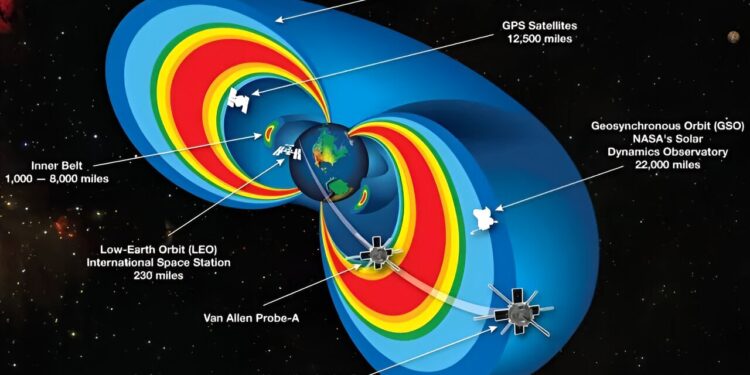This graphic shows a cross-section of Earth’s radiation belts with the two Van Allen Probes passing through them. Credit: NASA illustration
Two scientists at the University of Alaska Fairbanks have discovered a new type of “whistle,” an electromagnetic wave that carries a substantial amount of lightning energy into Earth’s magnetosphere.
The research is published today in Scientific progress.
Vikas Sonwalkar, professor emeritus, and Amani Reddy, assistant professor, discovered this new type of wave. The wave carries energy from lightning, which enters the ionosphere at low latitudes, to the magnetosphere. The energy is reflected upward by the lower boundary of the ionosphere, about 90 kilometers above sea level, in the opposite hemisphere.
Authors have long believed that lightning energy entering the ionosphere at low latitudes remains trapped in the ionosphere and therefore does not reach the radiation belts. These belts consist of two layers of charged particles surrounding the planet and held in place by the Earth’s magnetic field.
“As a society, we depend on space technology,” Sonwalkar said. “Modern communication and navigation systems, satellites and spacecraft with astronauts on board encounter harmful energetic particles from the radiation belts, which can damage electronic devices and cause cancer.
“It is essential for human operations in space to better understand the radiation belts and the variety of electromagnetic waves, including those from terrestrial lightning, that impact them,” he said.
Sonwalkar and Reddy’s discovery is a type of whistling wave that they call “specular reflection whistling.” Whistling waves produce a whistling sound when played through a loudspeaker.
Lightning energy entering the ionosphere at higher latitudes reaches the magnetosphere as a different type of whistle called a magnetospheric reflection whistle, which undergoes one or more reflections in the magnetosphere.
The ionosphere is a layer of the Earth’s upper atmosphere characterized by a high concentration of ions and free electrons. It is ionized by solar radiation and cosmic rays, making it conductive and essential for radio communications because it reflects and modifies radio waves.
The Earth’s magnetosphere is a region of space surrounding the planet that is created by the Earth’s magnetic field. It provides a protective barrier that prevents most particles from the solar wind from reaching the atmosphere and harming life and technology.
Sonwalkar and Reddy’s research shows that both types of whistles – specular reflection whistles and magnetospheric reflection whistles – coexist in the magnetosphere.
In their research, the authors used plasma wave data from NASA’s Van Allen probes, launched in 2012 and operating until 2019, and lightning data from the World Wide Lightning Detection Network.
They developed a wave propagation model that, considering specularly reflected whistles, showed the doubling of lightning energy reaching the magnetosphere.
Examination of Van Allen probe plasma wave data has shown that specularly reflected whistles are a common magnetospheric phenomenon.
Most lightning occurs at low latitudes, which are tropical and subtropical regions prone to thunderstorm development.
“This implies that specularly reflected whistles likely carry a larger portion of the lightning energy to the magnetosphere compared to that carried by magnetospherically reflected whistles,” Sonwalkar said.
The impact of lightning-generated whistling waves on radiation belt physics and their use in remote sensing of magnetospheric plasma have been the subject of research since the 1950s.
Sonwalkar and Reddy work in the Department of Electrical and Computer Engineering in the UAF College of Engineering and Mines. Reddy is also affiliated with the UAF Geophysical Institute.
Sonwalkar and Reddy’s research is supported by grants from the National Science Foundation and NASA EPSCoR, the program established to stimulate competitive research.
More information:
Vikas S. Sonwalkar et al, Specularly reflected whistle: a low-latitude channel for coupling lightning energy to the magnetosphere, Scientific progress (2024). DOI: 10.1126/sciadv.ado2657
Provided by University of Alaska Fairbanks
Quote: Scientists Discover Phenomenon Affecting Earth’s Radiation Belts (2024, August 17) retrieved August 18, 2024 from
This document is subject to copyright. Apart from any fair dealing for the purpose of private study or research, no part may be reproduced without written permission. The content is provided for informational purposes only.



